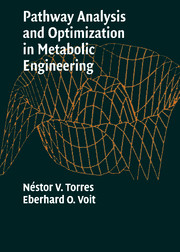Book contents
- Frontmatter
- Contents
- Preface
- 1 Target: A Useful Model
- 2 Methods of Biochemical Systems Theory
- 3 A Model of Citric Acid Production in the Mold Aspergillus niger
- 4 Optimization Methods
- 5 Optimization of Biochemical Systems
- 6 Optimization of Citric Acid Production in Aspergillus niger
- 7 Maximization of Ethanol Production in Saccharomyces cerevisiae
- 8 Conclusions
- Author Index
- Subject Index
- Plate section
- References
5 - Optimization of Biochemical Systems
Published online by Cambridge University Press: 28 July 2009
- Frontmatter
- Contents
- Preface
- 1 Target: A Useful Model
- 2 Methods of Biochemical Systems Theory
- 3 A Model of Citric Acid Production in the Mold Aspergillus niger
- 4 Optimization Methods
- 5 Optimization of Biochemical Systems
- 6 Optimization of Citric Acid Production in Aspergillus niger
- 7 Maximization of Ethanol Production in Saccharomyces cerevisiae
- 8 Conclusions
- Author Index
- Subject Index
- Plate section
- References
Summary
INTRODUCTION
The optimization of metabolic pathways has its roots in biochemistry and chemical engineering. Biochemistry has contributed with knowledge about enzyme kinetics and catalytic processes in vitro and in vivo, whereas chemical engineering has developed strategies of optimizing processes at the bench and large-scale industrial levels. Optimization of biochemical and biotechnological systems is a crucial component of the young field of metabolic engineering (e.g., Bailey 1991, 1998; Simpson, Colon, and Stephanopoulos 1995; Simpson, Follstad, and Stephanopoulos 1999; Stephanopoulos 1998; Stephanopoulos, Aristidou, and Nielsen 1998; Koffas et al. 1999).
In broad strokes, one may classify metabolic optimization tasks in five categories (Heinrich and Schuster 1996, Chapter 6). The first category deals with the maximization of reaction rates and steady-state fluxes. The second addresses the minimization of transition time, which yields higher productivity per time unit; we will discuss in Chapter 7 that this task is actually closely related to the optimization of concentrations and fluxes. The third is the minimization of intermediate metabolite concentrations. The fourth task is the optimization of thermodynamic efficiency, and the fifth task addresses optimal stoichiometry and network design.
Savageau (1976) established criteria specifically for the optimal functioning of metabolic pathways. He suggested the following seven: (1) minimization of changes in the level of end product, as the system shifts from one steady state to another in response to a change in demand; (2) responsiveness to changes in the availability of initial substrate; (3) insensitivity to perturbations in the structure of the systems itself; (4) limited accumulation of metabolic intermediates; (5) reduction of the synthesis of intermediate metabolites when end product is supplied exogenously; (6) stability; and (7) temporal responsiveness to change.
- Type
- Chapter
- Information
- Pathway Analysis and Optimization in Metabolic Engineering , pp. 162 - 196Publisher: Cambridge University PressPrint publication year: 2002



